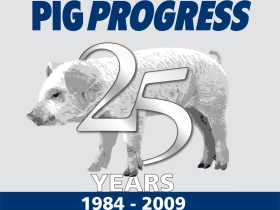Hyperprolificacy and the ‘shattered sow syndrome’

The Oxford English Dictionary defines hyperprolificacy as ‘super-abundant production of offspring’. Quite so. Thanks to the geneticist and the increasing skill of the ordinary producer, the 25 weaners/ sow/ year of ten years ago is now considered an acheivable target for anybody, and even passé by some.
These leaders are reaching 30, with 220 kg of weaner weight/year and 1.2 tonnes of weaner in a sow’s lifetime. Great stuff!
These impressively huge litters now being achieved have already outstripped the ability of the sow to rear them. She just cannot eat enough food – however excellently designed and made – to sustain the early growth rate of which her progeny are capable.
The geneticist has been at work in the growing area too. We now have available to us ‘early-getaway’ growth which can mean a material contribution to profit from the finished pig, from a week quicker to slaughter with 16 kg food saved and seven days saved overheads, thus 35 kg more saleable meat sold from each tonne of growing finishing food – you work out what that means in an equivalent reduction in your cost/tonne of feed! It makes quibbling with your feed supplier over a few pennies discount per tonne look like a very minor cost-saving exercise by comparison.
But why the impending hyperprolificacy bombshell?
Assuming the modern sow still needs to provide 4.25 g of milk for each g of piglet gain, to cut a long calculation short, she needs to eat over 5.5 kg of lactation food per day by day 4 from farrowing so as not to penalise the fast-getaway growth of 13 piglets with an average birthweight of 1.35 kg. And a great deal more as they sail past their genetically built-in capability of growing an average of 220 g/day by a four week weaning weight of 7.5 kg. Simply, the present-day and future litter doesn’t get enough milk, particularly early on in life.
But there are several other problems lying in wait.
The shattered sow syndrome
In the old days we all recognised the ‘thin sow syndrome’ which was mostly based on lack of visible fat cover down through lactation. We could see that – and/or feel it by condition scoring. Today this needs a new name. I’ve called it ‘the shattered sow syndrome’. Here the damage caused by plundering the sow by a voracious litter is internal, both in rebreeding hormone dysfunction (causing a delay in rebreeding and increased returns) and in too much loss of what the physiologists call ‘maternal protein’. Over 9 to 12% maternal protein loss seems critical and a 16 to 18% loss is likely in shattered sows. This is not all that obvious visually or tactually to the stockperson as the thin sow syndrome was.
Too much maternal protein loss
Three problems arise from this.
* Firstly, ovulation rate can be lowered due to fewer ovarian follicles being ready at weaning which reduces conception rate and subsequent litter size.
* Secondly, the weaned sow may have less mature follicular fluid present resulting in greater follicle and embryo death – reduced litter size again.
* Third, both milk yield and milk protein concentration reduce – thought to be due to a decrease of some essential amino acids needed as precursors for milk formation – which inevitably affects litter performance.
Management to the rescue!
Enough of the science! Is hyperprolificacy and its future second/ third litter challenges all gloom and doom? No. First, let the nutritionist design a maximal intake lactation ration and advise you on the latest ©mid- to late-gestation feeding advice – which is now changing. As a first line of defence these will blunt the arrow, but not win the battle.
However there are many things the breeder can do through management to keep the maternal protein losses in lactation to under the critical 9% level.
These measures I will outline in my next blog.











